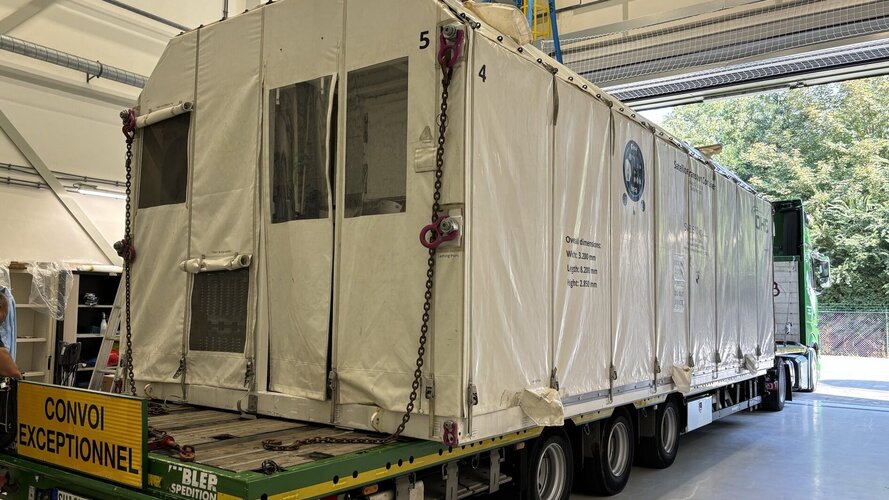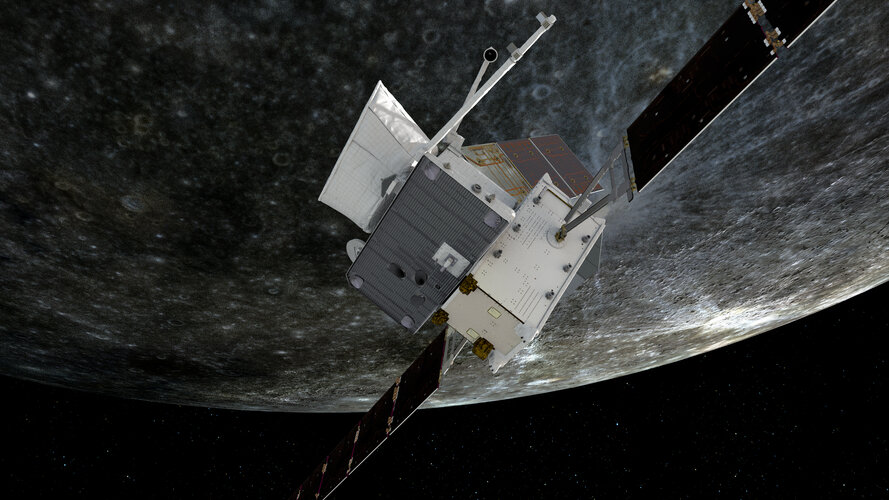Mission control GO for Sentinel-2C launch
Tuesday, 03 September 2024 07:00 Image:
Mission control GO for Sentinel-2C launch
Image:
Mission control GO for Sentinel-2C launch ESA delays BepiColombo orbital insertion because of thruster problem
Tuesday, 03 September 2024 02:09

Inside the 'golden age' of alien hunting at the Green Bank Telescope
Monday, 02 September 2024 20:52 Nestled between mountains in a secluded corner of West Virginia, a giant awakens: the Green Bank Telescope begins its nightly vigil, scanning the cosmos for secrets.
If intelligent life exists beyond Earth, there's a good chance the teams analyzing the data from the world's largest, fully steerable radio astronomy facility will be the first to know.
"People have been asking themselves t
Nestled between mountains in a secluded corner of West Virginia, a giant awakens: the Green Bank Telescope begins its nightly vigil, scanning the cosmos for secrets.
If intelligent life exists beyond Earth, there's a good chance the teams analyzing the data from the world's largest, fully steerable radio astronomy facility will be the first to know.
"People have been asking themselves t Q&A: Scientist discusses the MESSENGER mission to Mercury
Monday, 02 September 2024 16:41
Twenty years ago, the MESSENGER mission revolutionized our understanding of Mercury. We sat down with project head and former Carnegie Science director Sean Solomon to talk about how the mission came together and the groundbreaking work it enabled.
Q: As the principal investigator of the MESSENGER mission, what were your personal highlights or proudest moments throughout the mission's duration?
Sean Solomon: There were many personal highlights for me during the MESSENGER mission, beginning with our initial selection by NASA in 1999 and culminating in the publication by the MESSENGER science team of all of the findings from our mission in a book published nearly two decades later.
The most challenging events in any planetary orbiter mission are launch and orbit insertion. The successful completion of those two milestones for MESSENGER—in 2004 and 2011, respectively—were sources of great pride for me in the technical expertise of all of the engineers, mission design experts, and project managers who contributed to the mission.
The long flight portion of the mission provided multiple scientific highlights. MESSENGER's first flyby of Mercury in January 2008 yielded the first new spacecraft observations of Mercury in 33 years, and our team published 11 papers in a single issue of Science from those measurements six months later.
Watch Sentinel-2C launch live on the final Vega rocket
Monday, 02 September 2024 08:15
The Copernicus Sentinel-2C satellite is ready for liftoff! Tune in to ESA WebTV on 4 September from 03:30 CEST to watch the satellite soar into space on the last Vega rocket to be launched from Europe’s Spaceport in Kourou, French Guiana. Sentinel-2C is scheduled to liftoff at 03:50 CEST.
Goodbye Hera: asteroid mission departs ESA test centre
Monday, 02 September 2024 07:00
After a year of testing, ESA’s Hera asteroid mission for planetary defence is about to depart Europe and head towards its launch site in the USA. The Hera team looked on as the crated spacecraft – along with its twin miniature CubeSats and additional equipment – was driven away from ESA’s ESTEC Test Centre in Noordwijk, the Netherlands.
Fourth Mercury flyby begins BepiColombo’s new trajectory
Monday, 02 September 2024 06:00
Teams from across ESA and industry have worked continuously over the past four months to overcome a glitch that prevented BepiColombo’s thrusters from operating at full power. The ESA/JAXA mission is still on track, with a new trajectory that will take it just 165 km from Mercury’s surface on Wednesday.
Taking BepiColombo closer to Mercury than it’s ever been before, this flyby will reduce the spacecraft’s speed and change its direction. It also gives us the opportunity to snap images and fine-tune science instrument operations at Mercury before the main mission begins. Closest approach is scheduled for 23:48 CEST
NASA Discovers a Long-Sought Global Electric Field on Earth
Sunday, 01 September 2024 18:46 Using observations from a NASA suborbital rocket, an international team of scientists has, for the first time, successfully measured a planet-wide electric field thought to be as fundamental to Earth as its gravity and magnetic fields. Known as the ambipolar electric field, scientists first hypothesized over 60 years ago that it drove how our planet's atmosphere can escape above Earth's North an
Using observations from a NASA suborbital rocket, an international team of scientists has, for the first time, successfully measured a planet-wide electric field thought to be as fundamental to Earth as its gravity and magnetic fields. Known as the ambipolar electric field, scientists first hypothesized over 60 years ago that it drove how our planet's atmosphere can escape above Earth's North an Bubbling, frothing and sloshing: Long-hypothesized plasma instabilities finally observed
Sunday, 01 September 2024 18:46 Whether between galaxies or within doughnut-shaped fusion devices known as tokamaks, the electrically charged fourth state of matter known as plasma regularly encounters powerful magnetic fields, changing shape and sloshing in space. Now, a new measurement technique using protons, subatomic particles that form the nuclei of atoms, has captured details of this sloshing for the first time, potenti
Whether between galaxies or within doughnut-shaped fusion devices known as tokamaks, the electrically charged fourth state of matter known as plasma regularly encounters powerful magnetic fields, changing shape and sloshing in space. Now, a new measurement technique using protons, subatomic particles that form the nuclei of atoms, has captured details of this sloshing for the first time, potenti Satellite Data Enhances Understanding of Solar Power Generation in Asia Pacific
Sunday, 01 September 2024 18:46 Amid the ongoing energy crisis and the growing threat of climate change, the need to harness renewable energy sources has become increasingly urgent. Solar energy, in particular, is emerging as a leading candidate, with experts predicting it could become the primary energy source by the end of the century.
However, solar energy generation is not without challenges. Like wind power, solar i
Amid the ongoing energy crisis and the growing threat of climate change, the need to harness renewable energy sources has become increasingly urgent. Solar energy, in particular, is emerging as a leading candidate, with experts predicting it could become the primary energy source by the end of the century.
However, solar energy generation is not without challenges. Like wind power, solar i Greenland's Accelerated Warming Linked to Clear-Sky Radiation and Atmospheric Dynamics
Sunday, 01 September 2024 18:46 Global warming, fueled by human activities, has led to rising average temperatures across the globe. However, Greenland is experiencing warming at a rate faster than the global average, causing its ice sheets to melt more rapidly. This phenomenon, known as Arctic Amplification, could significantly raise sea levels, threatening coastal regions and ecosystems worldwide. Understanding the factors d
Global warming, fueled by human activities, has led to rising average temperatures across the globe. However, Greenland is experiencing warming at a rate faster than the global average, causing its ice sheets to melt more rapidly. This phenomenon, known as Arctic Amplification, could significantly raise sea levels, threatening coastal regions and ecosystems worldwide. Understanding the factors d NASA's Europa Clipper Equipped with Massive Solar Arrays for Jupiter Mission
Sunday, 01 September 2024 18:46 NASA's Europa Clipper spacecraft, the largest ever built for planetary exploration, has been fitted with a set of gigantic solar arrays at the Kennedy Space Center in Florida. These arrays, each measuring approximately 46.5 feet (14.2 meters) in length and 13.5 feet (4.1 meters) in height, are the largest ever developed by NASA for a planetary mission. Their size is crucial to harness the maximu
NASA's Europa Clipper spacecraft, the largest ever built for planetary exploration, has been fitted with a set of gigantic solar arrays at the Kennedy Space Center in Florida. These arrays, each measuring approximately 46.5 feet (14.2 meters) in length and 13.5 feet (4.1 meters) in height, are the largest ever developed by NASA for a planetary mission. Their size is crucial to harness the maximu NASA JPL Developing Underwater Robots to Venture Deep Below Polar Ice
Sunday, 01 September 2024 18:46 On a remote patch of the windy, frozen Beaufort Sea north of Alaska, engineers from NASA's Jet Propulsion Laboratory in Southern California huddled together, peering down a narrow hole in a thick layer of sea ice. Below them, a cylindrical robot gathered test science data in the frigid ocean, connected by a tether to the tripod that had lowered it through the borehole.
This test gave engin
On a remote patch of the windy, frozen Beaufort Sea north of Alaska, engineers from NASA's Jet Propulsion Laboratory in Southern California huddled together, peering down a narrow hole in a thick layer of sea ice. Below them, a cylindrical robot gathered test science data in the frigid ocean, connected by a tether to the tripod that had lowered it through the borehole.
This test gave engin 



